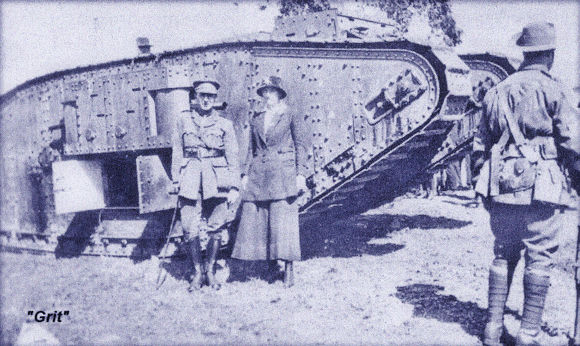 |
| "Grit"— First Tank to Arrive in Australia |
Pen & Sword Military, 2017
This title is somewhat misleading, as the book was first published as Pioneers of Australian Armour in the Great War. As such, it is of lesser scope than would otherwise be assumed. That being said, the text is an in-depth look at the beginning of Australian armor, from the first two volunteer-built armored cars (part 1) to the tank used as a crowd-pleasing fund-raiser in-country (part 2).
In early February 1916 the two armored cars were completed, the first a Daimler and the second a Mercedes. Training, staffing, etc. occurred until June, when the group embarked. In August, they arrived in Egypt and were attached to the 2nd Light Horse Brigade.
After patrolling and taking part in the actions in the Libyan desert, the crews switched to light Ford cars with machine guns and thus became the 1st Australian Light Car Patrol. They then patrol and fight in Palestine, are attached to various commands, are stationed at the Dead Sea, and participate in the Battle of Megiddo and the dash to Aleppo. After the Armistice, in January 1919, they battle with Kurdish bandits before going home.
Back in Australia, prior to receiving an actual tank, many different mock-ups were used to raise funds, some somewhat fanciful. When the real tank arrived in July 1918, and the fund-raising really started, the Mark IV female tank was named "Grit" by the wife of the South Australian Governor. Although "Grit" was not used in combat, it wowed the crowds in various cities and brought in many thousands of pounds for the war effort.
As the crews of the armored cars, the light car patrol, and "Grit" were not large, the authors are extremely detailed in the biographies of each crew member. This really gives the reader the flavor of Australian life at the time. The appendices include myriad details concerning the equipment, the timeline of the desert warfare, and even notes on tank driving.
If you are interested in the Anzac desert campaign, this is a wonderfully complete companion to that study.
Bruce Sloan

I'm always looking for that extra edge in Great War knowledge. Your review is excellent and I look forward to reading the work. Cheers
ReplyDeleteInteresting how German Mercedes' and Daimlers were used at the start of the campaign. I suspect spare parts was an issue. Excuse my ignorance, but what are the distinct differences of a male and female, tank that is?
ReplyDeleteThe male tank is armed with cannon & the female with machine guns
ReplyDelete